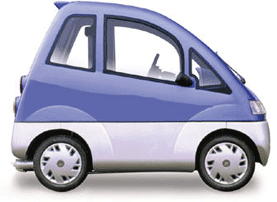

| Home| Airfares| Airlines| Van Rentals| Van Sales| Seniors| Advertise| Contact Us| Email A Friend|Link to Us |
|
|
|
|
- Featuring the Quovis and the Dreamers that Made it Reality - |
|
Quovis... More than Just a Dream By Clive Soden
A dream is how it started for both of them – a dream of developing a car you could drive from a wheelchair. |
|
The Quovis in Yellow |
A motorcycle accident in 1990 suddenly made Carlos Nunez a paraplegic. However, the accident was not about to make the European, thrill-seeking design engineer stay at home. Instead, Carlos started looking at the various vehicles for wheelchair users but was unhappy with the options available. Any vehicle worth driving needed adaptations and it was still difficult to use. It was then that Carlos started working on various concept vehicles. He modified used Fiats, Peugeots and Opels and adapted them for wheelchair use, but discovered that modifying someone else’s vehicle did not solve the problem. Carlos wanted to drive the car from the wheelchair and it had to be easy to use. He concluded that his dream vehicle must be made from the ground up. From this, the Quovis™ was born – the first purpose-built car for wheelchair users. He chose the name Quovis because it is Latin for “wherever you want to be.” |
|
Of course, it is one thing to create a concept vehicle and a totally different challenge to put the dream vehicle into production. He sought help from research grants, Regional Development Funding, and the collaboration of other designers and engineers. Then, in 1997, Vehículos Extremeños Especiales Ligeros, S.L. (VEXEL, S.L.) was formed to produce the Quovis. Pre-production models were made in 2000. After that, a sum of more than six million dollars was invested in the development of the Quovis resulting in substantial model improvements. During the time Carlos was recovering from his motorcycle accident, Abe Hopper, an automotive executive in the United States, was observing his mother-in-law struggle as she continued to lose the use of her legs. Marion Frederick’s disability was caused by spina bifida and her condition was getting worse with age. Abe observed the adapted vehicles and equipment that Marion purchased to keep her mobile. Marion had adaptive controls added to her Buick plus various other devices so she could pull the wheelchair into the car behind the front seat. For longer trips, Marion had a Chevrolet Van fitted with a lift. But this was still a burdensome process. First she had to wheel the chair onto the lift, then make sure the chair was secure, then finally struggle to move onto the van seat. And, upon arrival, it was the same process in reverse. “I never saw her get anywhere by car or van very quickly,” Abe said. “It always took at least 10 minutes for her to get into a vehicle.” He tried helping his mother-in-law once, but Mother Marion replied, “Thank you,” she said, “but, I’m perfectly able to do this myself.” Abe learned a valuable lesson from Marion: wheelchair users want to be independent. Like Carlos Nunez, Abe didn’t find anything on the market that was easy to use or purpose-built for wheelchair users. Everything was an adaptation from another vehicle. “It was always in the back of my mind,” Abe said, “that there had to be an easier way for a wheelchair user to get around town.” On a trip to Europe, Abe saw the Quovis – the dream vehicle of Carlos Nunez. Abe was excited and he knew then the Quovis was the answer to urban travel for wheelchair users. However, the European Quovis was not ready for the North American market. While in Europe, Abe discovered that the Quovis was classified as a quadricycle and could be driven on public streets. The quadricycle is strictly a classification based on weight and is not subjected to the same regulations as passenger cars. In North America, the National Highway Traffic Safety Administration (NHTSA) does not recognize the concept of a quadricycle, but has set safety standards for Low-Speed Vehicles (LSV). In North America, the Quovis can operate as an LSV for urban travel, so Abe worked with Vexel™ to produce a Quovis that exceeds the NHTSA safety standards for LSVs. “Then we had to consider urban travel in hot and humid climates,” Abe said. The result was an air-conditioned LSV powered by a fuel-injected, computer-controlled gasoline engine, which is coupled to a constant-velocity automatic transmission. The bonus from this technology is that the Quovis achieves superior gasoline mileage of 90 miles per gallon. It was at a Las Vegas exposition when Abe got confirmation that the Quovis was very much needed and on target. A partial paraplegic, Bill Eddins, was very excited when he saw the Quovis so Abe let him take it for a spin after the show. “The absolute glee on Bill’s face told the story,” Abe said. When Bill mentioned that he wanted a Quovis, Abe told him that was great but reminded him he already had a beautiful Avalanche outfitted with everything he needed. |
|
“Don’t you get it?” Bill replied. “The Avalanche is fine if I need to go to L.A. But, for around town, I don’t have to go through four chair changes just to get a quart of milk!” Abe did get it and he understood that the Quovis was now more than just a dream. For more information on the Quovis, visit www.quovis.com.
Clive Soden is a writer and Web developer. His Web site is: www.clivesoden.com. |
 The Quovis in Blue |
To return to the Making A Difference page, click here.
Copyright 2005, 2006 AccessTravelCenter.com. All rights reserved.